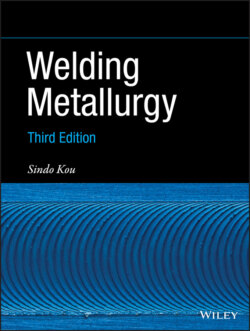Читать книгу Welding Metallurgy - Sindo Kou - Страница 42
1.3.7 Electroslag Welding 1.3.7.1 The Process
ОглавлениеESW is a process that melts and joins metals by heating them with a pool of molten slag held between the metals and continuously feeding a filler wire electrode into it, as shown in Figure 1.24. The weld pool is covered with molten slag, and it moves upward as welding progresses. A pair of water‐cooled copper shoes, one in the front of the workpiece and one behind it, keeps the weld pool and the molten slag from breaking out. Similar to SAW, the molten slag in ESW protects the weld metal from air and refines it. The arc exists only during the initiation period of the process, that is, when the arc heats up the flux and melts it. The arc is then extinguished, and the resistance heating generated by the electric current passing through the slag keeps it and the weld pool from freezing. In order to make heating more uniform, the electrode is often oscillated, especially when welding thicker sections. Figure 1.25 is the transverse cross section of an electroslag weld in a steel 7 cm thick [13]. Typical examples of the application of ESW include the welding of ship hulls, storage tanks, and bridges.
Figure 1.24 Electroslag welding: (a) overall process; (b) welding area enlarged.
Figure 1.25 Transverse cross section of electroslag weld in 70‐mm‐thick steel.
Source: Eichhorn, Remmel, Wubbels [13]. Welding Journal, January 1984, © American Welding Society.
